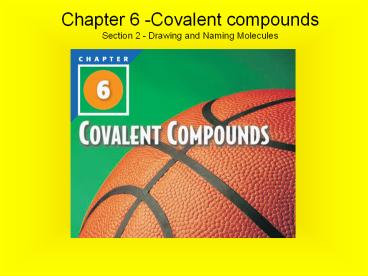Chapter 6 -Covalent compounds - PowerPoint PPT Presentation
Title:
Chapter 6 -Covalent compounds
Description:
Chapter 6 -Covalent compounds Section 2 - Drawing and Naming Molecules Chapter 6 -Covalent compounds Section 2 - Drawing and Naming Molecules Lewis Electron-Dot ... – PowerPoint PPT presentation
Number of Views:156
Avg rating:3.0/5.0
Title: Chapter 6 -Covalent compounds
1
Chapter 6 -Covalent compounds Section 2 - Drawing
and Naming Molecules
2
Chapter 6 -Covalent compounds Section 2 - Drawing
and Naming Molecules
Lewis Electron-Dot Structures
In 1920,G.N. Lewis, the American chemist came up
with a system to represent the valence electrons
of an atom. This system - known as electron-dot
diagrams or Lewis structures - uses dots to
represent valence electrons. Lewiss system is a
valuable model for covalent bonding.
A Lewis structure shows only the valence
electrons in an atom or molecule. The nuclei and
the electrons of the inner energy levels (if any)
of an atom are represented by the symbol of the
element.
3
Chapter 6 -Covalent compounds Section 2 - Drawing
and Naming Molecules
Group Valence e- Electron Dot Structure (example)
1
2
13
14
15
16
17
18
1
2
3
4
5
6
7
8
4
Chapter 6 -Covalent compounds Section 2 - Drawing
and Naming Molecules
Rules for Electron Dot Structures
1. Each atoms is drawn with its symbol surrounded
by one dot for each of its valence numbers. No
more than 2 dots to a side.
2. Determine if you are drawing an ionic or
covalent substance.
Ionic Must show the charges due to lose/gain of
electron(s), anions are to be placed in brackets
X2-
Covalent Must show the shared pair(s) of
electrons
3. No more than 8 electrons around any atom. (H,
He, B, and Be will only have 2)
4. Covalent may have up to 3 bonds between atoms.
5
Chapter 6 -Covalent compounds Section 2 - Drawing
and Naming Molecules
Draw dot structures for CH4
6
Chapter 6 -Covalent compounds Section 2 - Drawing
and Naming Molecules
Draw dot structures for NaCl
7
Chapter 6 -Covalent compounds Section 2 - Drawing
and Naming Molecules
Draw dot structures for H2O
8
Chapter 6 -Covalent compounds Section 2 - Drawing
and Naming Molecules
Draw dot structures for NH4
9
Chapter 6 -Covalent compounds Section 2 - Drawing
and Naming Molecules
Draw dot structures for CaSO4
10
Chapter 6 -Covalent compounds Section 2 - Drawing
and Naming Molecules
Draw dot structures for MgCl2
11
Chapter 6 -Covalent compounds Section 2 - Drawing
and Naming Molecules
Draw dot structures for CO2
12
Chapter 6 -Covalent compounds Section 2 - Drawing
and Naming Molecules
Draw dot structures for F2
13
Chapter 6 -Covalent compounds Section 2 - Drawing
and Naming Molecules
Naming Covalent Compounds
Covalent compounds made of two elements are named
by using a method similar to the one used to name
ionic compounds.
Covalent Compounds usually list the most
electronegative element last. This element will
have the ide ending that is usually found on
ions.
The first element listed will keep its periodic
table name.
For example, SO2
The first element keeps its periodic name --
Sulfur
The last element picks up the ide ending --
Oxide
14
Chapter 6 -Covalent compounds Section 2 - Drawing
and Naming Molecules
Prefixes Indicate How Many Atoms Are in a Molecule
Prefixes are used to tell how many of each
element are found in each molecule. A prefix is
added to the name of the first element and one is
added to the second element.
Prefix Number Prefix Number
1 6
2 7
3 8
4 9
5 10
Mono
Hexa
Di
Hepta
Tri
Octa
Nona
Tetra
Penta
Deca
15
Chapter 6 -Covalent compounds Section 2 - Drawing
and Naming Molecules
Prefixes are not used on the first element if
there is only one of them.
SO2
Nitrogen Dioxide
Sulfur Dioxide
NO2
SO3
Carbon Monoxide
Sulfur Trioxide
CO
P4O6
Dinitrogen Tetraoxide
Tetraphosphorus Hexaoxide
N2O4
16
The diatomic 7
There are seven molecules that commonly bond with
themselves and form a diatomic molecule (molecule
with two atoms). These molecules are never found
in nature as atoms, only in their diatomic form.
They will keep their atomic name.
Hydrogen H2 Nitrogen N2 Oxygen O2 Fluorine F2
Chlorine Cl2 Bromine Br2 Iodine I2
17
Chapter 6 -Covalent compounds Section 2 - Drawing
and Naming Molecules
Review
Which is the correct electron-dot formula for a
molecule of chlorine?
Which electron-dot diagram best represents a
compound that contains both ionic and covalent
bonds?
18
Chapter 6 -Covalent compounds Section 2 - Drawing
and Naming Molecules
Review
Which molecule contains a polar covalent bond?
What is the correct Lewis electron-dot structure
for the compound magnesium fluoride?
19
Chapter 6 -Covalent compounds Section 2 - Drawing
and Naming Molecules
Review
Which diagram below shows the correct Lewis
electron-dot diagram for a molecule of phosphorus
trichloride, PCl3?
Which Lewis electron-dot diagram is correct for
CO2?
20
Chapter 6 -Covalent compounds Section 2 - Drawing
and Naming Molecules
Review
- What is the IUPAC name for P2O5?
- Phosphorus Oxide
- Diphosphorus Pentaoxygen
- Diphosphorus Oxide
- Diphosphorus Pentaoxide
- What is the formula for Nitrogen Disulfide?
- NS
- N2S
- NS2
- N2S2
21
Chapter 6 -Covalent compounds Section 2 - Drawing
and Naming Molecules
Review
22
Chapter 6 -Covalent compounds Section 2 - Drawing
and Naming Molecules
Review































